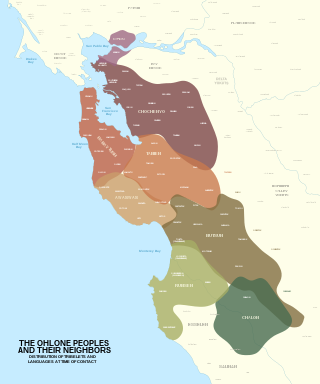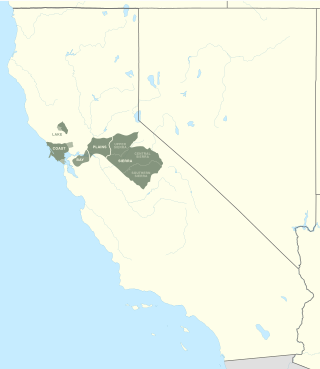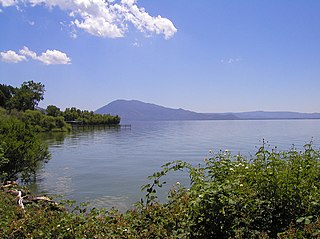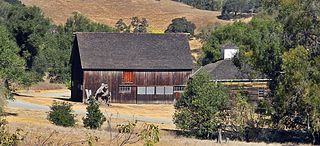
Sonoma County is a county located in the U.S. state of California. As of the 2020 United States Census, its population was 488,863. Its seat of government and largest city is Santa Rosa.

The Ohlone, formerly known as Costanoans, are a Native American people of the Northern California coast. When Spanish explorers and missionaries arrived in the late 18th century, the Ohlone inhabited the area along the coast from San Francisco Bay through Monterey Bay to the lower Salinas Valley. At that time they spoke a variety of related languages. The Ohlone languages make up a sub-family of the Utian language family. Older proposals place Utian within the Penutian language phylum, while newer proposals group it as Yok-Utian.

The Miwok are members of four linguistically related Native American groups indigenous to what is now Northern California, who traditionally spoke one of the Miwok languages in the Utian family. The word Miwok means people in the Miwok languages.
The Bay Miwok are a cultural and linguistic group of Miwok, a Native American people in Northern California who live in Contra Costa County. They joined the Franciscan mission system during the early nineteenth century, suffered a devastating population decline, and lost their language as they intermarried with other native California ethnic groups and learned the Spanish language.

Bodega Bay is a shallow, rocky inlet of the Pacific Ocean on the coast of northern California in the United States. It is approximately 5 mi (8 km) across and is located approximately 40 mi (60 km) northwest of San Francisco and 20 mi (32 km) west of Santa Rosa. The bay straddles the boundary between Sonoma County to the north and Marin County to the south. The bay is a marine habitat used for navigation, recreation, and commercial and sport fishing.

Sonoma Valley is a valley located in southeastern Sonoma County, California, in the North Bay region of the San Francisco Bay Area. Known as the birthplace of the California wine industry, the valley is home to some of the earliest vineyards and wineries in the state, some of which survived the phylloxera epidemic of the 1870s and the impact of prohibition in the early 20th century. Today, the valley's wines are promoted by the U.S. federal government's Sonoma Valley and Carneros AVAs.
The Federated Indians of Graton Rancheria, formerly known as the Federated Coast Miwok, is a federally recognized American Indian tribe of Coast Miwok and Southern Pomo Indians. The tribe was officially restored to federal recognition in 2000 by the U.S. government pursuant to the Graton Rancheria Restoration Act.

The Petaluma River is a river in the California counties of Sonoma and Marin that becomes a tidal slough for most of its length. The headwaters are in the area southwest of Cotati. The flow is generally southward through Petaluma's old town, where the waterway becomes navigable, and then flows another 10 mi (16 km) through tidal marshes before emptying into the northwest corner of San Pablo Bay.

The Lake Miwok are a branch of the Miwok, a Native American people of Northern California. The Lake Miwok lived in the Clear Lake basin of what is now called Lake County. While they did not have an overarching name for themselves, the Lake Miwok word for people, Hotsa-ho, was suggested by A. L. Kroeber as a possible endonym, keeping with a common practice among tribal groups and the ethnographers studying them in the early 20th Century and with the term Miwok itself, which is the Central Sierra Miwok word for people.

The Plains and Sierra Miwok were once the largest group of California Indian Miwok people, Indigenous to California. Their homeland included regions of the Sacramento Valley, San Joaquin Valley, and the Sierra Nevada.

Olompali State Historic Park is a 700-acre (2.8 km2) California State Park in Marin County, California. It consists of the former Rancho Olómpali and was the site of the famed Battle of Olómpali during the Bear Flag Revolt. Rancho Olómpali was purchased by the Californian government in 1977, which turned it into a public park.
Tolay Creek is a 12.5-mile-long (20.1 km) southward-flowing stream in southern Sonoma County, California, United States, which flows through Tolay Lake and ends in north San Pablo Bay.
Camilo Ynitia was born in about 1803, in Marin County, southern Marin, of the Huiman tribe near Sausalito. The family likely traveled up to Olompali, where his father had built an adobe brick home. Camilo was a leader of the Coast Miwok. Camilo was known as the last Hoipu (headman) of the Miwok community living at Olompali and the Coast Miwoks of the Southern Marin Band. Camilo was also the only Native American on the northern frontier of Alta California to secure and keep a large Mexican-era land grant: In 1843 Governor Manuel Micheltorena of Alta California deeded him the Rancho Olompali, a large tract of land that is between present-day Novato and Petaluma, California. A part of this land now comprises the Olompali State Historic Park.

Nicasio Creek is an 11.9-mile-long (19.2 km) stream in Marin County, California, United States and is the primary tributary of Lagunitas Creek, which flows, in turn, into Tomales Bay, and the Pacific Ocean. The Nicasio Reservoir, formed in 1961 by Seeger Dam, is located on this stream.
Tomales High School is located in the town of Tomales, California, United States. It is the comprehensive high school of the Shoreline Unified School District. It serves the western Marin and Sonoma County communities, stretching from the towns of Point Reyes Station and Inverness along Tomales Bay, running north past the fishing port of Bodega Bay to the mouth of the Russian River, a distance of nearly 50 miles (80 km), and widening 13 miles (21 km) east from the west coast. Tomales High School draws its students from approximately 450 square miles (1,200 km2). Tomales High School was recognized as a California Distinguished School in 2011.

Rancho Olómpali was a 8,877-acre (35.92 km2) Mexican land grant in present-day Marin County, California given in 1834 by governor Manuel Micheltorena to Camilo Ynitia, son of a Coast Miwok chief. The name Olómpali comes from the Coast Miwok language and likely means southern village or southern people. The land grant is between present-day Novato and Petaluma. A part of this land now comprises the Olompali State Historic Park.
Chief Marin was the "great chief of the tribe Licatiut", according to General Vallejo's semi-historical report to the first California State Legislature in 1850. Historical records indicate that he was baptized as a young man at Mission San Francisco de Asís in 1801 and eventually moved to Mission San Rafael Arcángel, where he was an alcalde in the 1820s. Marin died on March 15, 1839, of natural causes. Marin County and the Marin Islands are believed to be named in his honor.
Rancho Nicasio was a Mexican land grant of 56,807 acres (230 km2) granted to the Coast Miwok indigenous people in 1835, located in the present-day Marin County, California, a tract of land that stretched from San Geronimo to Tomales Bay. Today, Nicasio, California is at the heart of this location.
Olompali is a former Native American settlement in Marin County, California. It was located 5 miles (8 km) south of Petaluma.
Tsupu, also known as Wild Cucumber, Maria Chekka, and Maria Chica, was a Coast Miwok elder. She was the last native of the ancient village of Petaluma, which was east of the Petaluma River and about three and a half miles northeast of the present city of Petaluma, California. It was part of Lekatuit Nation and had around 500 residents. "Petaluma" means "sloping ridge" in the Coast Miwok language.















